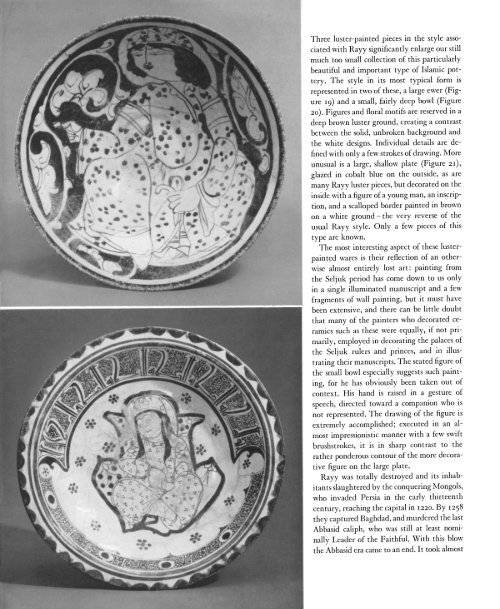Islamic Art: The Metropolitan Museum of Art Bulletin, v. 23, no. 6 ...
Islamic Art: The Metropolitan Museum of Art Bulletin, v. 23, no. 6 ...
Islamic Art: The Metropolitan Museum of Art Bulletin, v. 23, no. 6 ...
You also want an ePaper? Increase the reach of your titles
YUMPU automatically turns print PDFs into web optimized ePapers that Google loves.
Three luster-painted pieces in the style asso-<br />
ciated with Rayy significantly enlarge our still<br />
much too small collection <strong>of</strong> this particularly<br />
beautiful and important type <strong>of</strong> <strong>Islamic</strong> pottery.<br />
<strong>The</strong> style in its most typical form is<br />
represented in two <strong>of</strong> these, a large ewer (Figure<br />
I9) and a small, fairly deep bowl (Figure<br />
20). Figures and floral motifs are reserved in a<br />
deep brown luster ground, creating a contrast<br />
between the solid, unbroken background and<br />
the white designs. Individual details are defined<br />
with only a few strokes <strong>of</strong> drawing. More<br />
unusual is a large, shallow plate (Figure 2I),<br />
glazed in cobalt blue on the outside, as are<br />
many Rayy luster pieces, but decorated on the<br />
inside with a figure <strong>of</strong> a young man, an inscription,<br />
and a scalloped border painted in brown<br />
on a white ground -the very reverse <strong>of</strong> the<br />
usual Rayy style. Only a few pieces <strong>of</strong> this<br />
type are k<strong>no</strong>wn.<br />
<strong>The</strong> most interesting aspect <strong>of</strong> these lusterpainted<br />
wares is their reflection <strong>of</strong> an otherwise<br />
almost entirely lost art: painting from<br />
the Seljuk period has come down to us only<br />
in a single illuminated manuscript and a few<br />
fragments <strong>of</strong> wall painting, but it must have<br />
been extensive, and there can be little doubt<br />
that many <strong>of</strong> the painters who decorated ceramics<br />
such as these were equally, if <strong>no</strong>t primarily,<br />
employed in decorating the palaces <strong>of</strong><br />
the Seljuk rulers and princes, and in illustrating<br />
their manuscripts. <strong>The</strong> seated figure <strong>of</strong><br />
the small bowl especially suggests such painting,<br />
for he has obviously been taken out <strong>of</strong><br />
context. His hand is raised in a gesture <strong>of</strong><br />
speech, directed toward a companion who is<br />
<strong>no</strong>t represented. <strong>The</strong> drawing <strong>of</strong> the figure is<br />
extremely accomplished; executed in an almost<br />
impressionistic manner with a few swift<br />
brushstrokes, it is in sharp contrast to the<br />
rather ponderous contour <strong>of</strong> the more decorative<br />
figure on the large plate.<br />
Rayy was totally destroyed and its inhabitants<br />
slaughtered by the conquering Mongols,<br />
who invaded Persia in the early thirteenth<br />
century, reaching the capital in 1220. By I258<br />
they captured Baghdad, and murdered the last<br />
Abbasid caliph, who was still at least <strong>no</strong>minally<br />
Leader <strong>of</strong> the Faithful. With this blow<br />
the Abbasid era came to an end. It took almost

















